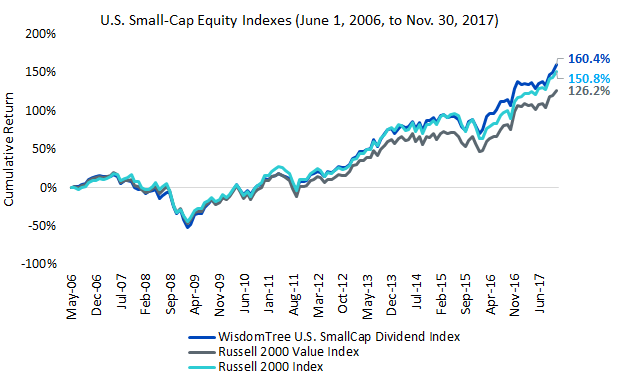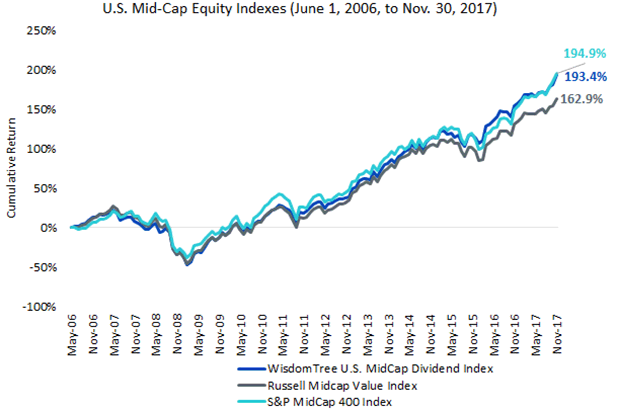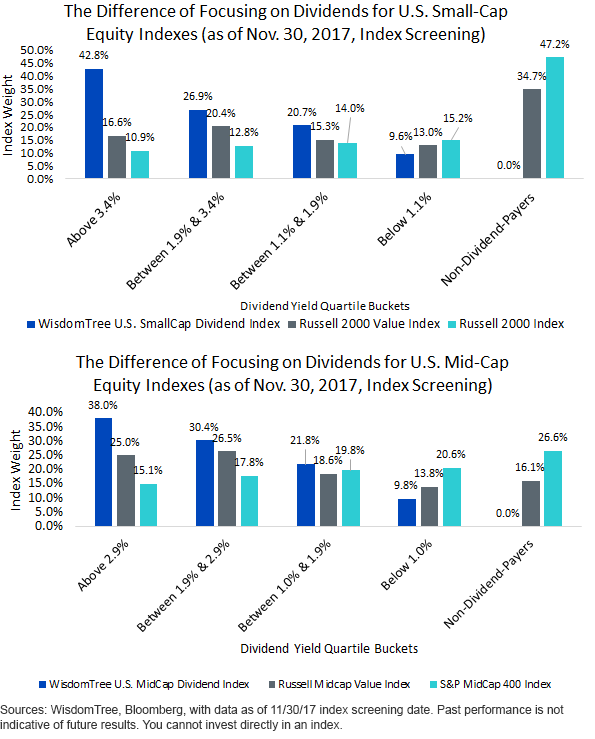How a Dividend Rebalance Works in Mid- and Small-Cap Stocks


For more than 11 years, WisdomTree has been running dividend-focused Indexes in the United States. Some of the strongest results against the more commonly followed market capitalization-weighted benchmark indexes have occurred in the mid- and small-cap size segments. How has this occurred? Was there anything unique going on during this period?
WisdomTree’s 2017 U.S. dividend rebalancing process provides an appropriate time to reassess this question.
Significance of Growth Style Outperformance => Dividend Disadvantage?
Growth has dramatically outperformed value since WisdomTree’s U.S. Dividend Indexes began their live track record—if we think about the types of companies that dominate the news cycle these days (FANG stocks, to name a few), it makes sense.1
- Since June 1, 2006, the Russell 2000 Growth Index returned 9.2% per year, nearly 2 full percentage points per year ahead of the Russell 2000 Value Index. As of November 30, 2017, the Russell 2000 Growth Index had 59% of its weight in stocks that didn’t pay dividends in the prior year, which compared to the Russell 2000 Value Index at 34.7% on this same measure.
- Over the same period, the Russell Midcap Growth Index returned 9.5% per year, versus 8.8% per year for the Russell Midcap Value Index. More than one-third of the Russell Midcap Growth Index was in stocks that didn’t pay dividends, whereas only about 16% of the Russell Midcap Value Index was in such stocks as of the same date.
So a picture is developing. First, growth has dramatically outperformed over a period of more than 11 years. Second, “dividends” are more of a value than a growth phenomenon. It would appear that strategies focused on dividends would therefore be at a disadvantage over this period.
What’s important to really measure, therefore, is whether the core benchmark—which includes BOTH the value AND growth stocks—had the advantage over the live performance history.
In Small-Caps, WisdomTree Outperformed; in Mid-Caps, WisdomTree Came Quite Close




- Small Caps: The Russell 2000 Index is one of the most widely followed equity market benchmarks in the world. We saw earlier how the growth-oriented cut of this Index dramatically outperformed the value cut, and yet the WisdomTree U.S. SmallCap Dividend Index outperformed the Russell 2000 Index by 0.35% per year, equating to almost 10 percentage points cumulatively over the full period. Compared to the Russell 2000 Value Index, the WisdomTree U.S. SmallCap Dividend Index opened up a gap of more than 34 percentage points cumulatively over the period.
- Mid-Caps: The S&P MidCap 400 Index has been one of the toughest indexes for any equity strategy to outperform in the recent decade, but even though it includes non-dividend-paying mid-cap growth stocks, it outperformed the WisdomTree U.S. MidCap Dividend Index by only 1.5 percentage points cumulatively over more than 11 years. On a Sharpe ratio basis, the difference between these two mid-cap Indexes was almost indistinguishable.
Disciplined, Annual Rebalancing Has Made the Difference for WisdomTree
Even if it is true that “dividends” as a strategy tend to tilt more toward value than growth in mid-cap and small-cap U.S. equities, the live track record shows that WisdomTree’s approach and methodology have generated more performance octane than the traditional value-oriented approaches. To review the core of WisdomTree’s methodology:
- The most critical relationship regards the behavior of a stock’s share price and the growth in its Dividend Stream® (dividend per share x number of shares outstanding).
- If the share price outperformed the growth in the stock’s Dividend Stream, then that stock would tend to see reduction in weight at WisdomTree’s rebalance.
- If the share price underperformed the growth in the stock’s Dividend Stream, then that stock would tend to see increasing weight at WisdomTree’s rebalance.
The concept retilts back toward growing fundamentals and away from appreciating share prices that aren’t well-supported by improving fundamentals.
Illustrating a Dividend Stream Rebalancing Process for U.S. Mid- and Small-Cap Stocks

- The WisdomTree U.S. SmallCap Dividend Index saw the 2017 rebalance push almost 43% of its weight into stocks with dividend yields above 3.4%. That created a massive difference compared to the Russell 2000 Index, which had only about 10.9% of its weight in such stocks; 47.2% of the Russell 2000 Index’s weight was in stocks that hadn’t paid any dividends over the prior 12 months.
- The WisdomTree U.S. MidCap Dividend Index saw the 2017 rebalance push 38% of its weight into stocks with dividend yields above 2.9%. Similar to what we saw with small caps, this created a very large difference compared to the S&P MidCap 400 Index.
Valuation Makers vs. Valuation Takers
We wrote about this with regard to our U.S. Earnings Indexes, where it is a bit more visible because an earnings-focused rebalance tends to lower the widely followed price-to-earnings (P/E) ratios. However, tilting weight toward higher-dividend-yielding stocks is simply a different way to lower valuations and create potential opportunities in markets that few would argue are inexpensive based on the strong overall U.S. equity markets we’ve seen.
1Performance period is 6/1/06 to 11/30/17. Weight in non-dividend-paying stocks is as of 11/30/17.

Christopher Gannatti began at WisdomTree as a Research Analyst in December 2010, working directly with Jeremy Schwartz, CFA®, Director of Research. In January of 2014, he was promoted to Associate Director of Research where he was responsible to lead different groups of analysts and strategists within the broader Research team at WisdomTree. In February of 2018, Christopher was promoted to Head of Research, Europe, where he was based out of WisdomTree’s London office and was responsible for the full WisdomTree research effort within the European market, as well as supporting the UCITs platform globally. In November 2021, Christopher was promoted to Global Head of Research, now responsible for numerous communications on investment strategy globally, particularly in the thematic equity space. Christopher came to WisdomTree from Lord Abbett, where he worked for four and a half years as a Regional Consultant. He received his MBA in Quantitative Finance, Accounting, and Economics from NYU’s Stern School of Business in 2010, and he received his bachelor’s degree from Colgate University in Economics in 2006. Christopher is a holder of the Chartered Financial Analyst Designation.

